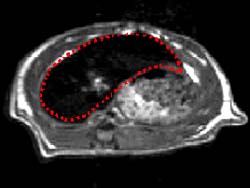

Since the first successful attempt in the early 1970s, the magnetic resonance imaging (MRI) as a non-invasive diagnostic tool has seen rapid and wide applications in medicine. However, new types of contrast agents remain to be developed for further improving the sensitivity and specificity of MRI.
Recently, a group of researchers headed by GAO Mingyuan from the CAS Institute of Chemistry, have developed a much simpler synthetic technique for producing biocompatible magnetite nanocrystals that could be used as MRI contrast agents for both in vitro and in vivo tumor detection.
Rather than adopting sophisticated post-preparative processes, Gao and his coworkers have developed a new facile route for producing water-soluble magnetic nanoparticles by "one-pot" reaction. In this new technique, the commonly used nonpolar high-boiling-point solvents were replaced by 2-pyrrolidone. As the carbonyl group in 2-pyrrolidone presents a weaker binding affinity to ferric ions in comparison with carboxylic group, an in situ biocompatible modification for the magnetite nanocrystals was allowed by partly capping the nanocrystal surface with carboxyl-terminated poly(ethylene glycol) (PEG). The PEG-coating turned out to be essential for improving the biocompatibility of the resultant nanocrystals. Following similar strategy, they recently reported the preparation of biocompatible Fe3O4 nanocrystals with surface reactive moieties using α,ω-dicarboxyl-terminated poly(ethylene glycol) (HOOC-PEG-COOH) as the surface capping agents. By the surface reactive carboxylic moieties, they further attached a cancer-targeting anti-body to the particle surface via an amidation reaction. The conjugates obtained turned out to be able to target cancer cells in both in-vitro and in-vivo cancer detection by MRI.
The simplicity of the new synthetic route and the excellent performance of the Fe3O4 nanocrystals suggested a promising future of their application as MRI contrast agents for magnetic resonance molecular imaging.
The research results on tumor detections have lately been published by Advanced Materials on Oct 4, 2006 and the "one-pot" reaction for synthesizing biocompatible magnetic nanoparticles was previously published by the same journal on April 18, 2005.
The research was jointly supported by the national High-tech development Program and National Natural Science Foundation of China.








